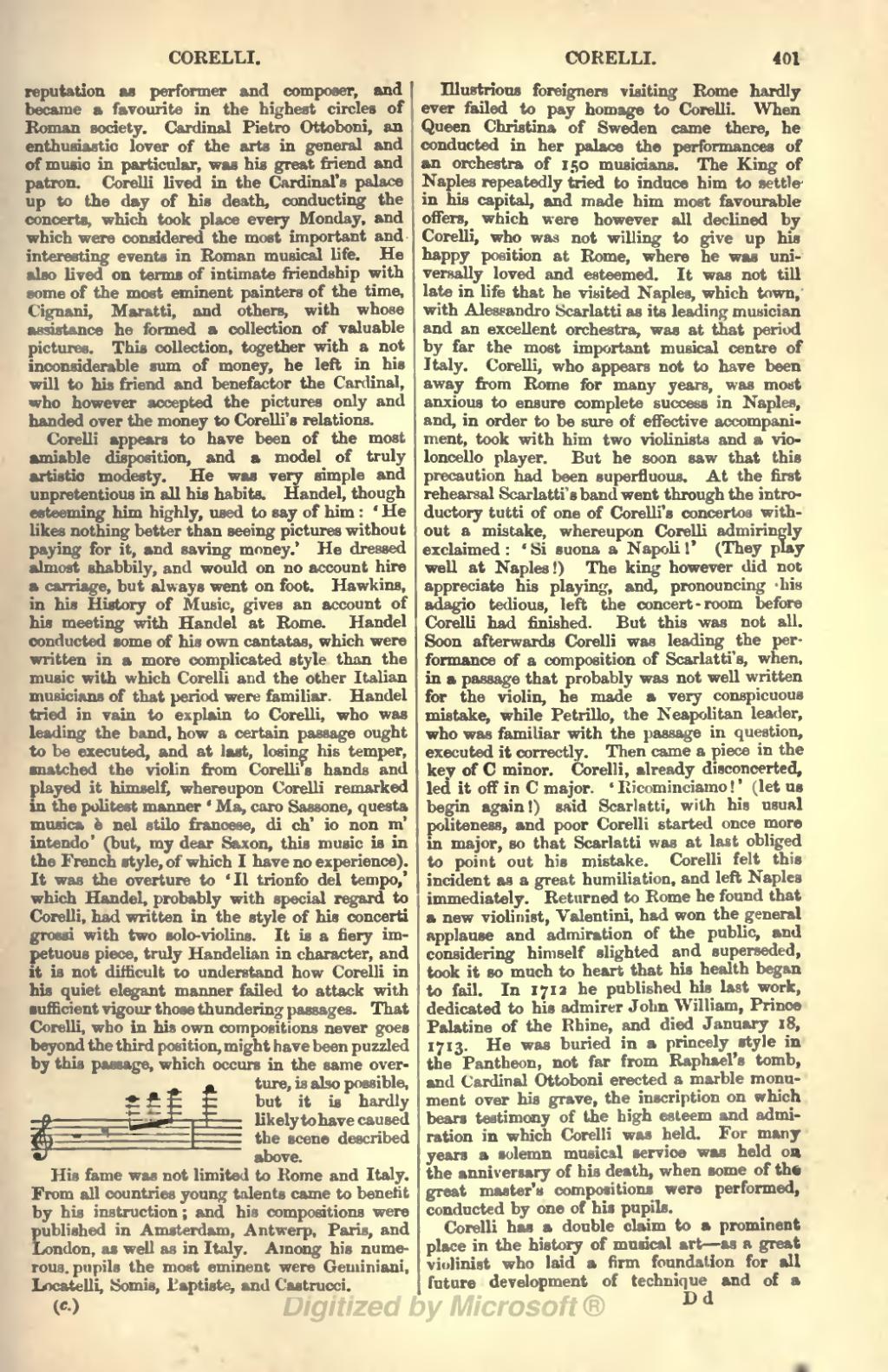reputation as performer and composer, and became a favourite in the highest circles of Roman society. Cardinal Pietro Ottoboni, an enthusiastic lover of the arts in general and of music in particular, was his great friend and patron. Corelli lived in the Cardinal's palace up to the day of his death, conducting the concerts, which took place every Monday, and which were considered the most important and interesting events in Roman musical life. He also lived on terms of intimate friendship with some of the most eminent painters of the time, Cignani, Maratti, and others, with whose assistance he formed a collection of valuable pictures. This collection, together with a not inconsiderable sum of money, he left in his will to his friend and benefactor the Cardinal, who however accepted the pictures only and handed over the money to Corelli's relations.
Corelli appears to have been of the most amiable disposition, and a model of truly artistic modesty. He was very simple and unpretentious in all his habits. Handel, though esteeming him highly, used to say of him: 'He likes nothing better than seeing pictures without paying for it, and saving money.' He dressed almost shabbily, and would on no account hire a carriage, but always went on foot. Hawkins, in his History of Music, gives an account of his meeting with Handel at Rome. Handel conducted some of his own cantatas, which were written in a more complicated style than the music with which Corelli and the other Italian musicians of that period were familiar. Handel tried in vain to explain to Corelli, who was leading the band, how a certain passage ought to be executed, and at last, losing his temper, snatched the violin from Corelli's hands and played it himself, whereupon Corelli remarked in the politest manner 'Ma, caro Sassone, questa musica è nel stilo francese, di ch' io non m' intendo' (but, my dear Saxon, this music is in the French style, of which I have no experience). It was the overture to 'II trionfo del tempo,' which Handel, probably with special regard to Corelli, had written in the style of his ccmcerti grossi with two solo-violins.
![{ \override Score.TimeSignature #'stencil = ##f \time 3/2 r1 r8 e'''[ f''' g'''] a'''4 }](http://upload.wikimedia.org/score/2/5/25l4bls35hs04mkkypq9zvjqblg669m/25l4bls3.png)
It is a fiery impetuous piece, truly Handelian in character, and it is not difficult to understand how Corelli in bis quiet elegant manner failed to attack with sufficient vigour those thundering passages. That Corelli, who in his own compositions never goes beyond the third position, might have been puzzled by this passage, which occurs in the same overture, is also possible, but it is hardly likely to have caused the scene described above.
His fame was not limited to Rome and Italy. From all countries young talents came to benefit by his instruction; and his compositions were published in Amsterdam, Antwerp, Paris, and London, as well as in Italy. Among his numerous, pupils the most eminent were Geminiani, Locatelli, Somis, Baptiste, and Castrucci.
Illustrious foreigners visiting Rome hardly ever failed to pay homage to Corelli. When Queen Christina of Sweden came there, he conducted in her palace the performances of an orchestra of 150 musicians. The King of Naples repeatedly tried to induce him to settle in his capital, and made him most favourable offers, which were however all declined by Corelli, who was not willing to give up his happy position at Rome, where he was universally loved and esteemed. It was not till late in life that he visited Naples, which town, with Alessandro Scarlatti as its leading musician and an excellent orchestra, was at that period by far the most important musical centre of Italy. Corelli, who appears not to have been away from Rome for many years, was most anxious to ensure complete success in Naples, and, in order to be sure of effective accompaniment, took with him two violinists and a violoncello player. But he soon saw that this precaution had been superfluous. At the first rehearsal Scarlatti's band went through the introductory tutti of one of Corelli's concertos without a mistake, whereupon Corelli admiringly exclaimed: 'Si suona a Napoli!' (They play well at Naples!) The king however did not appreciate his playing, and, pronouncing his adagio tedious, left the concert-room before Corelli had finished. But this was not all. Soon afterwards Corelli was leading the performance of a composition of Scarlatti's, when, in a passage that probably was not well written for the violin, he made a very conspicuous mistake, while Petrillo, the Neapolitan leader, who was familiar with the passage in question, executed it correctly. Then came a piece in the key of C minor. Corelli, already disconcerted, led it off in C major. 'Ricominciarao!' (let us begin again!) said Scarlatti, with his usual politeness, and poor Corelli started once more in major, so that Scarlatti was at last obliged to point out his mistake. Corelli felt this incident as a great humiliation, and left Naples immediately. Returned to Rome he found that a new violinist, Valentini, had won the general applause and admiration of the public, and considering himself slighted and superseded, took it so much to heart that his health began to fail. In 1712 he published his last work, dedicated to his admirer John William, Prince Palatine of the Rhine, and died January 18, 1713. He was buried in a princely style in the Pantheon, not far from Raphael's tomb, and Cardinal Ottoboni erected a marble monument over his grave, the inscription on which bears testimony of the high esteem and admiration in which Corelli was held. For many years a solemn musical service was held on the anniversary of his death, when some of the great master's compositions were performed, conducted by one of his pupils.
Corelli has a double claim to prominent place in the history of musical art—as a great violinist who laid a firm foundation for all future development of technique and of a

